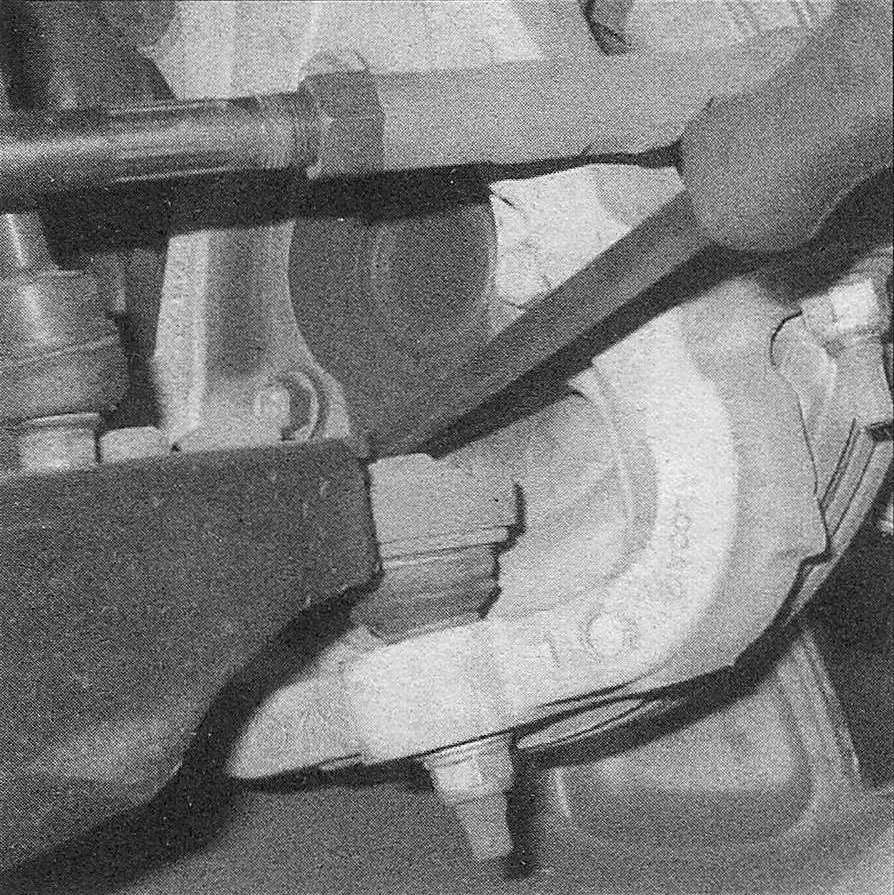Balljoints – replacement
1. Inspect the control arm balljoints for looseness any time either of them is separated from the steering knuckle. See if you can turn the ballstud in its socket with your fingers. If the balljoint is loose, or if the ballstud can be turned, replace the balljoint. You can also check the balljoints with the suspension assembled as follows.
Upper balljoints
Independent front suspension
2. Raise the lower control arm with a floor jack until the tire just barely touches the ground.
3. Using a large prybar inserted between the upper control arm and the steering knuckle, pry upwards on the upper control arm. The manu-
facturer specifies up to 0.020-inch movement is allowed; a dial indicator can be used to check for play. If you are unable to accurately measure balljoint play, have the balljoint checked at an automotive repair shop.
4. If replacement is indicated, loosen the wheel lug nuts, raise the front of the vehicle and support it securely on jackstands. Place a floor jack under the lower control arm, near the outer end, and raise it until the upper control arm lifts off its rebound bumper. Warning: The jack must remain in this position throughout the entire procedure.
5. The balljoint is press fit in the lower control arm, which necessitates the use of a special press tool and receiver cup to remove and install the balljoint. Equipment rental yards and some auto parts stores have these tools available for rent. If you don’t have access to this tool, remove the control arm (Upper control arm (front) – removal and installation) and take it to an automotive machine shop or other qualified repair facility to have the balljoint replaced. Note: Some balljoint replacement tools are similar to a heavy-duty C-clamp. With this type of tool it is only necessary to separate the balljoint from the steering knuckle.
Link/coil suspension
6. Raise the vehicle and support it securely on jackstands. Grasp the top of the tire and rock the tire in and out. If there is significant movement at the balljoint, have the balljoint checked by an automotive repair shop.
7. If replacement is indicated, the ball-joints on 4WD solid axle models are a press fit in the axle tube yoke, which necessitates the use of a special press tool and receiver cup to remove and install them. Equipment rental yards and some auto parts stores have these tools available for rent. If you don’t have access to this tool, take the vehicle to an automotive machine shop or other qualified repair facility to have the balljoint replaced.
8. If you have access to this tool, remove the hub/bearing assembly (see Clutch and driveline).
9. Remove the knuckle (Steering knuckle – removal and installation).
10. Remove the axleshaft (see Clutch and driveline).
11. Remove the snap-ring from lower balljoints, then use the balljoint removal tool to press out the balljoint.
12. Installation is the reverse of removal.
Lower balljoints
Independent front suspension
13. Raise the vehicle and support it securely on jackstands.
14. Place a floor jack under the lower control arm, near the outer end, and raise it until the upper control arm lifts off its rebound bumper.
15. Insert a prybar between the top of the balljoint and the steering knuckle and pry down (see illustration). The manufacturer specifies up to 0.020-inch movement is allowed; a dial indicator can be used to check for play. If you are unable to accurately measure balljoint play, have the balljoint checked at an automotive repair shop.
8.15 Pry down on the balljoint to check for wear
16. If replacement is indicated, remove the lower control arm (Lower control arm (front) – removal and installation); the balljoint is press fit in the lower control arm, which necessitates the use of a special press tool and receiver cup to remove and install the balljoint. Equipment rental yards and some auto parts stores have these tools available for rent. If you don’t have access to this tool, take the vehicle to an automotive machine shop or other qualified repair facility to have the balljoint replaced. Note: Some balljoint replacement tools are similar to a heavy-duty C-clamp. With this type of tool it is only necessary to separate the balljoint from the steering knuckle (Steering knuckle – removal and installation). Note: The lower balljoints on some models are replaceable, but on others they’re not. Check with your local auto parts store to check on the availability of replacement parts before disassembling your vehicle.
Link/coil suspension
17. Raise the vehicle and support it securely on jackstands.
18. Using a large prybar, pry upwards on the bottom of the steering knuckle, checking for significant movement at the balljoint. If there is significant movement at the balljoint, have the balljoint checked by an automotive repair shop.
19. If replacement is indicated, the ball-joints on 4WD solid axle models are a press fit in the axle tube yoke, which necessitates the use of a special press tool and receiver cup to remove and install them. Equipment rental yards and some auto parts stores have these tools available for rent. If you don’t have access to this tool, take the vehicle to an automotive machine shop or other qualified repair facility to have the balljoint replaced.
20. If you have the tool, refer to Steps 8 through 12 for the replacement procedure.
